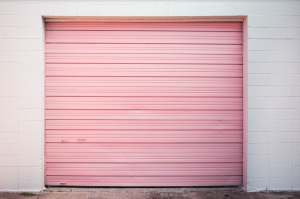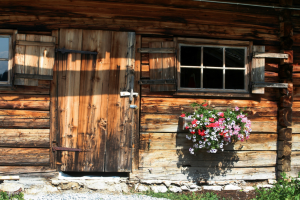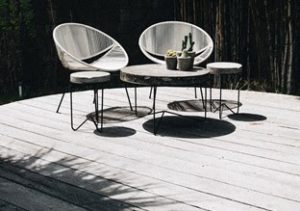With the sun finally shining, you might be prioritising renovating the outdoor areas of your home. When it comes to painting, it’s important to remember that paint isn’t just for indoors; you can easily bring your exterior to life with fresh colour and style. Outdoor paints also help to protect structures and surfaces against external elements. The task does not need to be a big DIY project if you know what elements you are working with. Before you decide on a paint, you need to understand the type and quality of your surface as this will indicate the preparation needed. For example, older surfaces need to be dry, and any rust must be sanded down. Ultimately, each paint type has pros and cons, dependent on the size and texture of the area.
To guide you through the best paint to use for three key exterior surfaces, property expert at HomeHow.co.uk, Natalie Mitchell has shared her secrets.
-
Garage doors

If your garage door is looking rusty, adding a splash of paint can neaten up the outside of your home. Before choosing the colour, you need to consider what type of paint is right for your door. It’s important to pick a day that is above 10 degrees otherwise the paint won’t dry and will leave you with an uneven finish. Before you start, use a flat scraper to remove any old paint as this will leave you with a smooth workspace.
Galvanised metal paint
If you have a metal garage door, galvanised metal paint will produce an effective finish and prolong your garage door’s lifespan. The average cost of metal paint is around £12 to £50 for a litre.
Galvanised metal paint is temperature-resistant which means it is not worn down by UV rays or ice. If your garage door is rusting, metal paint can easily cover this up without the cost of making repairs. For beginners, the application process for metal paint can be quite difficult as the solutions are thick. Patience is required as the process can take longer to finish but the colour will withhold.
Exterior paint
Exterior paint can be used on any surface that is exposed to weather conditions. They tend to be priced at £4 to £20 per litre. Exterior paint is made to tolerate adverse weather conditions and protect against rusting. However, the paint tends to change colour once it has been cured, and over time the colour will fade, so regular maintenance is needed.
2. Sheds

Whether you’ve had a new shed built this year or the existing one needs renovating, you should always scrub before painting. Sheds can attract cobwebs, mud and mould, so use a diluted general-purpose cleaner and a hard wire brush to scrub away any excess. The removal will make the paint application effortless. Just make sure that the wood is completely dry before painting.
Exterior high gloss paint
If you want your shed to be a statement in your garden, the best paint is exterior high-gloss paint which costs around £5 to £40 per litre. Exterior high-gloss paint is ideal for improving the colour of your shed, while protecting the wood from damage. It’s also easy to clean, meaning the maintenance of removing any dirt or debris takes minutes. High-gloss paint can highlight imperfections, if you have any large damages to your shed, this paint might not be the best option. During application precise coverage is needed to avoid evident brush marks.
Weatherproof paint
Weatherproof paint will protect sheds against severe weather conditions. The average cost of weatherproof paint is around £15 to £30 per litre. The paint is water-resistant, meaning any heavy rainfall will leave your shed intact. It can help to lower humidity, protect against UV rays. Whilst weatherproof paint can limit damage caused by weather, you may have to use extra precautions such as a primer or oil to prevent widespread damage.
3. Decking

Garden decking looks effective in any garden. However, it does need to be painted frequently to maintain the appearance. Paint helps to refresh the look whilst protecting it against external elements such as UV rays and rainwater which creates cracks. Always prepare your decking before and only paint in dry weather conditions. Decking paint won’t dry in cold weather and if it has recently rained, the wood will be wet in texture.
Anti-slip decking paint
Anti-slip paint is made up of epoxy resin which is a protective coating for garden decking. The cost of anti-slip decking paint is around £4 to £8 per litre. The resistant surface makes the decking safer. It can also extend the lifespan and durability by protecting against damage. If the decking is not prepared properly, it will reduce the efficiency of the anti-slip paint. It can take up to 4 days to complete your entire decking with anti-slip decking paint.
Decking oil
Decking oil is used to penetrate timber decking which protects the installation from the inside. The average cost of decking oil is £8 to £16 per litre. Decking oil is water-resistant, preventing damp from damaging your decking when hosing or during heavy rainfall. It also contains UV protection. Decking oils are not suitable for exotic hardwood decking as they are naturally oily woods and wouldn’t react well to further oil being added. Decking oil tends to change colour once it is applied and cured.
Decking stain
Decking stain is like varnish which lays on top of the surface for protection. The price of decking stain is around £8 to £12 per litre. Decking stain will provide a shielding surface layer to maintain protection and durability. Unlike decking oil, there are a variety of different shades available. However, if the seal is broken on the decking stain layer, it can flake off, allowing moisture to enter the timber.
